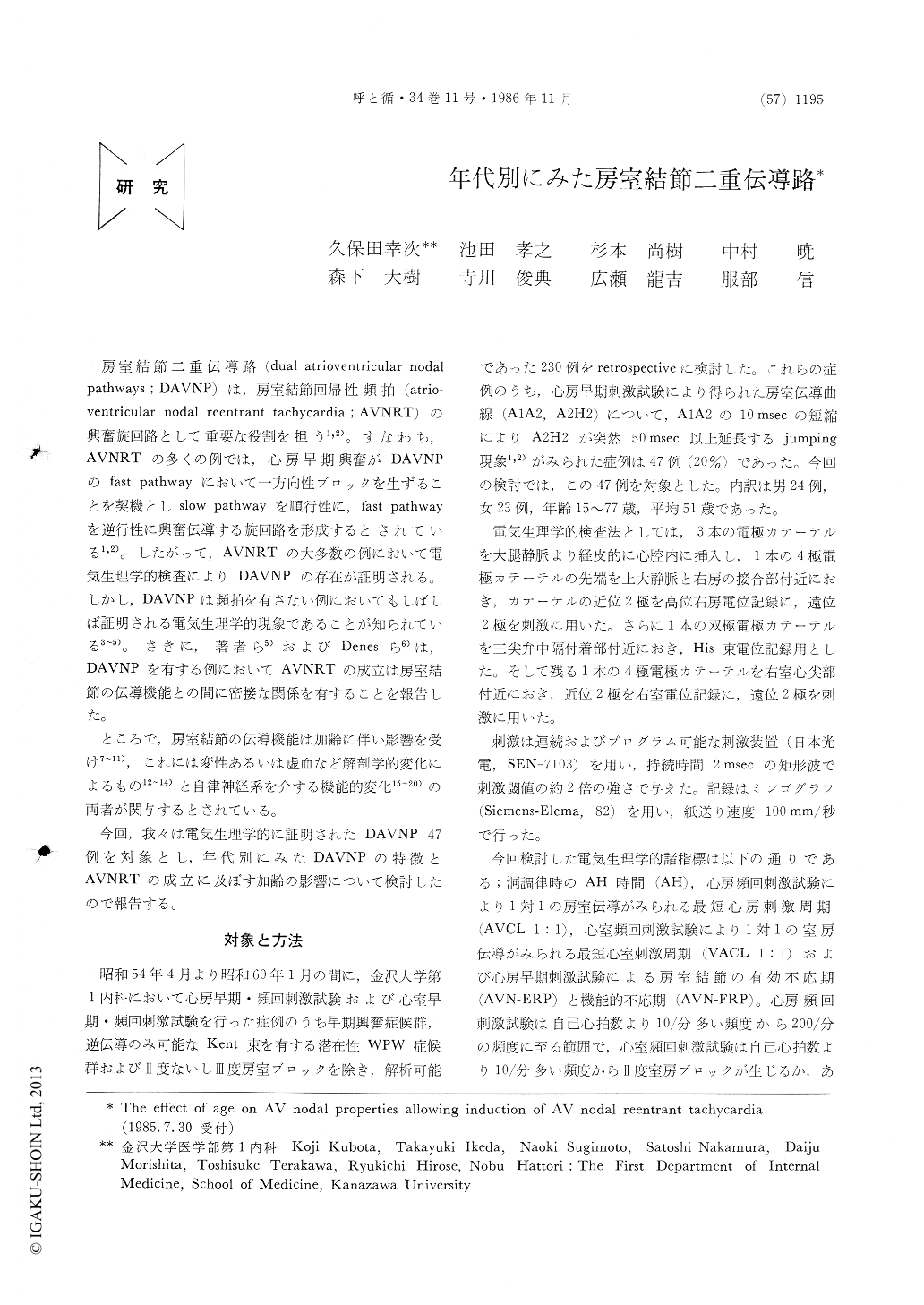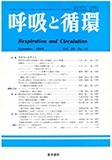Japanese
English
- 有料閲覧
- Abstract 文献概要
- 1ページ目 Look Inside
房室結節二重伝導路(dual atrioventricular nodalpathways;DAVNP)は,房室結節回帰性頻拍(atrio—ventricular nodal reentrant tachycardia;AVNRT)の興奮旋回路として重要な役割を担う1,2)。すなわち,AVNRTの多くの例では,心房早期興奮がDAVNPのfast pathwayにおいて一方向性ブロックを生ずることを契機としslow pathwayを順行性に,fast pathwayを逆行性に興奮伝導する旋回路を形成するとされている1,2)。したがって,AVNRTの大多数の例において電気生理学的検査によりDAVNPの存在が証明される。しかし,DAVNPは頻拍を有さない例においてもしばしば証明される電気生理学的現象であることが知られている3〜5)。さきに,著者ら5)およびDenesら6)は,DAVNPを有する例においてAVNRTの成立は房室結節の伝導機能との間に密接な関係を有することを報告した。
ところで,房室結節の伝導機能は加齢に伴い影響を受け7〜11),これには変性あるいは虚血など解剖学的変化によるもの12〜14)と自律神経系を介する機能的変化15〜20)の両者が関与するとされている。
We examined 47 patients with dual atrioventricular (AV) nodal pathways in order to delineate the effect of age on AV nodal properties allowing of AV nodal reentry.
In 16 out of 47 patients, spontaneous paroxysmal supraventricular tachycardia was documented clinically and AV nodal reentrant tachycardia could be demon-strated during electrophysiological studies. AV nodal conduction time (AH), refractory periods of the AV node (AVN-ERP and AVN-FRP) and the shortest paced cycle length with 1 : 1 AV nodal conduction (AVCL 1:1) in the patients with and without AV nodal reentrant tachycardia were, respectively : AH 80.0±15.1 (mean±SD) and 99.5±33.5 msec (p< 0.05), AVN-ERP 258.3±24.1 and 338.3±171.0 msec (p<0.001), AVN-FRP 400.6±37.0 and 481.1±96.0 msec (p<0.01) and AVCL 1 : 1 364.4±41.9 and 484.2±125.2 msec (p<0.001).
AV nodal reentrant tachycardia was commoner in the patients with dual AV nodal pathways between the age of 40 and 59 years (group B ; S out of 1S) than in patients before age 40 years (group A ; 2 out of 11) and than in patients after age 60 years (group C ; 6 out of 1S) . AH, AVN-ERP, AVN-FRP and AVCL 1 : 1 in the group A, B and C were, respectively AH 96.4±49.7, 86.4±22.7 and 97.2±19.3 msec, AVN-ERP 330.0±113.0, 290.6±46.4 and 331.3± 56.0 msec (p<0.05 : B vs C), AVN-FRP 480.5± 117.3, 412.5±43.8 and 478.3±192.7 msec (p<0. 05 : A vs B, p<0.02 : B vs C) and AVCL 1 : 1 480.0± 166.2, 387.2±50.4 and 477.2±118.0 msec (p< 0.02 : A vs B, p<0.01 : B vs C).
Regardless of whether AV nodal dysfunction observed in the group A and C may be due to functional or anatomic disintegration of the node, induction of AV nodal reentrant tachycardia is considered to be associated with AV nodal properties for enhanced conduction.

Copyright © 1986, Igaku-Shoin Ltd. All rights reserved.


